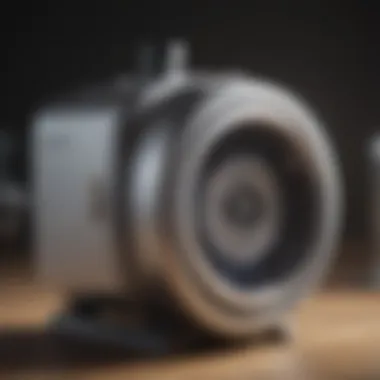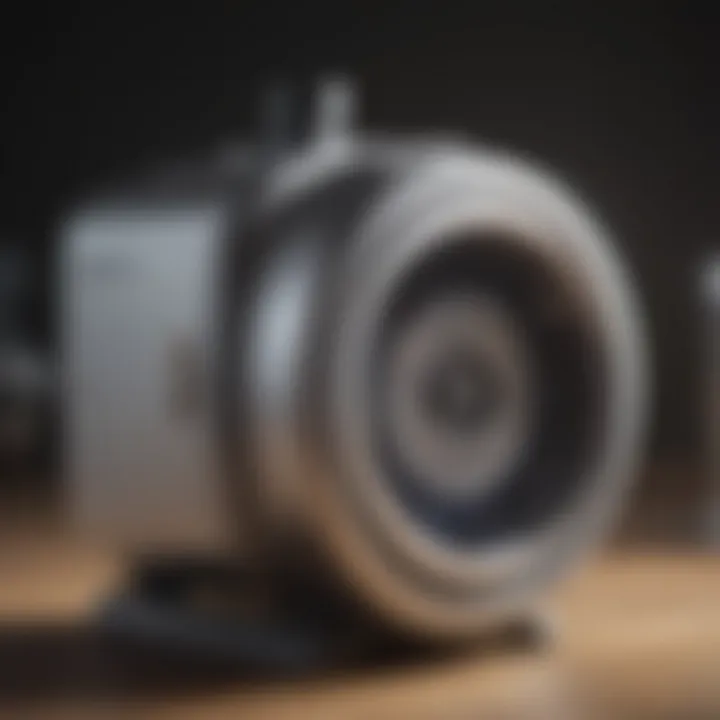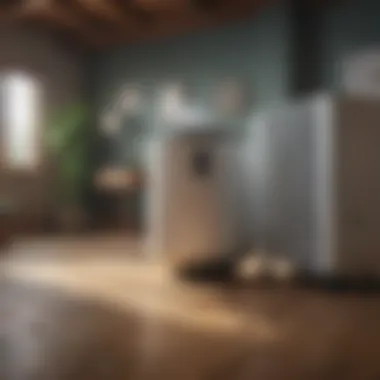The Risks of Ionic Air Purifiers: A Comprehensive Guide


Intro
Indoor air quality has become a significant concern for many households, particularly for those with pets. As various purification devices gain prevalence, ionic air purifiers stand out. They are frequently marketed as a means to enhance air quality. However, scrutiny behind their safety and effectiveness poses questions that merit investigation.
This article dives into the potential risks associated with ionic air purifiers. It considers operational functioning, health consequences, and effectiveness when compared to other methods. Also explored are ozone production and regulatory perspectives, aimed at helping consumers make informed decisions regarding air purification, especially in homes with pets.
Understanding Ionic Air Purifiers
Ionic air purifiers utilize charged ions to remove particles from the air. The principle is quite straightforward. They release negative ions, which attach to positive particles like dust or pollen. When they bind together, they become heavier and fall to the ground or stick to surfaces. While this mechanism sounds effective at cleaning the air, it raises several concerns regarding its operational safety and overall efficacy.
Ozone Production
A significant aspect that often garners attention is the production of ozone by ionic air purifiers.
- Ozone Generation: When these purifiers release negative ions, some may also produce ozone. This gas can be harmful to health, particularly for those with respiratory issues, like asthma.
- Health Risks: Ozone exposure can lead to difficulties in breathing, throat irritation, and other health concerns. Thus, consumers must evaluate if the benefits outweigh the associated risks.
"When using ionic air purifiers, it is essential to measure the balance between improved air quality and the potential hazard of ozone emissions."
Effectiveness Compared to Other Methods
In terms of efficiency, ionic purifiers may not stand up well against alternatives such as HEPA filters.
- HEPA Filters: Known for their ability to capture a wide range of particles, HEPA filters are extensively tested and proven to improve indoor air quality without releasing harmful substances.
- Comparison Challenges: While ionic purifiers may be marketed as effective, the lack of extensive scientific validation contrasts sharply with the established efficacy of HEPA filtration.
Regulatory Perspectives
Finally, regulatory bodies have varying stances on the use of ionic air purifiers. In some regions, these appliances are scrutinized due to their ozone output. It's crucial for consumers to be aware of local regulations and guidelines before deciding on such devices.
- Product Listings: Knowing whether a device complies with safety standards can assist in making better choices.
- Research Recommendations: For consumers prioritizing air quality, researching manufacturer's testing results and certifications can provide valuable insights.
Closure
Ionic air purifiers may seem like a quick fix for achieving cleaner indoor air; however, the potential risks associated with them cannot be understated. Ozone production, questions about their effectiveness compared to more reliable devices like HEPA filters, and the stance of regulatory bodies complicate their use. For pet owners and families, understanding these nuances can lead to more informed decisions about air purification in their homes.
Understanding Ionic Air Purifiers
Understanding ionic air purifiers is crucial for anyone considering improving their indoor air quality. These devices are often marketed with strong claims regarding their ability to clean air effectively. However, to comprehend their actual functionality and implications, a detailed examination is vital. This article will clarify how these purifiers operate, what potential risks they pose, and who should consider their use.
Definition and Functionality
Ionic air purifiers, also known as ionizers, are devices that use charged particles to remove pollutants from the air. They typically release negative ions, which attach to positively charged particles such as dust, pollen, and smoke. This causes the particles to clump together and become too heavy to remain airborne, effectively removing them from the environment. The main appeal lies in their ability to operate without filters, which often require frequent replacements and maintenance. While this feature may seem beneficial, the lack of physical filtration systems raises important questions about effectiveness and safety.
How Ionic Purifiers Work
Ionic purifiers function through a process called ionization. When the device is turned on, it generates negative ions. These ions drift in the air and collide with particles. The attachment of negative ions to airborne contaminants leads to an increase in their mass. Consequently, heavier particles fall to the ground or adhere to nearby surfaces, such as walls and furniture. This process may help improve the perception of air quality; however, it is essential to recognize that not all particles are captured in this manner. Moreover, there are concerns regarding the potential byproducts of ionization, specifically ozone, which can be harmful in elevated concentrations.
"Ionic purifiers may reduce certain allergens in the air, but they can also produce harmful ozone, which raises significant health concerns."
In summary, understanding ionic air purifiers involves acknowledging both their operational principles and the associated health implications. It is not enough to consider their advertised benefits; one must weigh the risks presented by ozone production and the incomplete removal of harmful particles. By grasping these elements, consumers can make informed choices about air purifiers, especially in homes where pets or children are present.


The Appeal of Ionic Air Purifiers
Ionic air purifiers have drawn significant interest in recent years, largely due to their promising claims of improving indoor air quality. As awareness about air pollution rises, consumers are increasingly seeking solutions to enhance their living environments. Ionic air purifiers often present themselves as a modern answer to this need. They are marketed as effective devices that can eliminate allergens, bacteria, and unpleasant odors. This appeal, however, must be scrutinized in light of potential downsides and misunderstandings of how these machines work.
Claims and Benefits
The primary claims surrounding ionic air purifiers focus on their ability to purify air through the release of negatively charged ions. Proponents suggest that these ions attach to airborne particles, which ultimately makes them heavier and causes them to settle out of the air. Some of the touted benefits include:
- Reduction of Allergens: Many shoppers believe ionic purifiers can significantly decrease dust, pollen, and pet dander levels in homes, making them especially attractive for families with children and pet owners.
- Odor Elimination: Users often expect these purifiers to neutralize odors from cooking, pets, and other common sources, thus contributing to a fresher indoor atmosphere.
- Low Maintenance and Noise Levels: Unlike traditional filters, ionic purifiers do not require frequent filter replacements and are typically quieter, appealing to those who fear disturbance during sleep.
While these claims are enticing, it is essential for consumers to delve deeper into their legitimacy and underlying science.
Consumer Trends
Consumer interest in air quality solutions is on a noticeable upswing. The COVID-19 pandemic has heightened awareness around airborne transmission of viruses, leading to a greater focus on air purification technology. According to recent surveys, purchasers of ionic air purifiers include a diverse demographic, primarily:
- Health-Conscious Individuals: Many people are motivated by a desire to protect their families, especially those with respiratory issues.
- Pet Owners: Concern for pets has led owners to seek devices that promise cleaner air free from allergens and odors.
- Eco-Friendly Consumers: Some ionic purifiers are marketed as environmentally friendly options, appealing to those wary of the ecological impact of traditional air purifiers.
This shift in consumer behavior underscores the growing importance of home air quality. However, education is crucial here. Buyers must discern between the marketed benefits and the risks associated with ionic technologies to make informed choices for their households.
Potential Health Risks
Understanding the potential health risks associated with ionic air purifiers is essential for consumers, particularly for families with children and pet owners. While these devices claim to improve indoor air quality, they also introduce elements that may pose health hazards. The significance of these risks is underscored by debates surrounding ozone emissions, respiratory issues, and the well-being of pets in such environments. As people seek ways to maintain healthy living spaces, it becomes crucial to have access to comprehensive information surrounding the implications of using ionic air purifiers.
Ozone Emission Concerns
One of the most notable risks linked to ionic air purifiers is the emission of ozone. Ozone is a gas that can be detrimental to health, particularly for individuals with respiratory conditions. Ionic purifiers often generate ozone as a byproduct of their operation. This occurs when the device ionizes air particles, creating negatively charged ions that can attach to various pollutants. In some cases, this process also produces ozone, which can cause irritation in the lungs and worsen asthma symptoms.
The Environmental Protection Agency (EPA) has set limits for acceptable ozone levels in indoor environments, emphasizing the importance of monitoring these outputs from air purification devices. For those who consider purchasing an ionic air purifier, understanding the specifications and whether the model in question emits ozone within safe parameters is vital.
"Ozone can lead to increased susceptibility to respiratory infections and decreased lung function, especially among children and pets."
Respiratory Issues
Beyond ozone generation, ionic air purifiers may instigate various respiratory issues. For susceptible individuals, including those with asthma and allergies, the introduction of charges ions into the air can provoke adverse reactions. These devices often produce particles that can amplify existing health problems or even create new ones. Some users have reported symptoms like coughing, wheezing, or throat irritations after prolonged use of ionic purifiers.
Moreover, the effectiveness of these units in removing allergens from the air has been questioned. Unlike HEPA filters, which capture particles effectively, ionic purifiers primarily charge particles without guaranteeing they are removed from the living environment. Thus, individuals relying on ionic purifiers to manage allergies or asthma may find limited improvements in their air quality.
Impact on Pets
The impact of air quality on pets is another significant concern when it comes to ionic air purifiers. Pets, such as dogs and cats, can be particularly sensitive to changes in indoor air conditions. Ozone emissions can be harmful to them, leading to respiratory distress or exacerbating pre-existing health problems. Animals rely heavily on their sense of smell, and ozone can interfere with their olfactory navigation.
In addition to ozone, pets may react negatively to particles released by ionic purifiers. Symptoms in pets can range from coughing to lethargy, which can lead owners to misunderstand their pet’s health conditions. Consequently, families with pets must carefully assess the potential risks ionic air purifiers may pose to their beloved animals, encouraging them to seek alternatives that ensure a safe environment for both humans and their furry companions.
Regulatory Perspectives
Regulatory perspectives are crucial when evaluating ionic air purifiers. The importance lies in ensuring that these devices do not pose health risks to users and that they meet safety standards. By understanding the guidance from regulatory bodies, consumers can make informed choices while weighing the benefits and drawbacks of using ionic air purifiers in their homes.
Additionally, regulatory oversight helps in maintaining public trust. When consumers see that products are scrutinized and regulated, it instills confidence that their health and safety are priorities. Sound regulations can also pave the way for innovation and improvement within the appliance market, leading to better solutions for air purification.
FDA and EPA Guidelines


The Food and Drug Administration (FDA) and the Environmental Protection Agency (EPA) play significant roles in establishing guidelines concerning air purifiers. The FDA's involvement primarily focuses on devices marketed for medical purposes or that may affect human health. In this regard, they assess the efficacy and safety of devices to ensure they do not cause harm, particularly from harmful emissions such as ozone.
On the other hand, the EPA provides broad guidance on air quality and the safety of products contributing to indoor environments. The agency emphasizes that while some ionic air purifiers claim to reduce pollutants, they often do so inefficiently. Particularly, the EPA has raised concerns about the generation of ozone, which can be detrimental to both health and the environment. It's essential for consumers to look for devices that comply with these agency guidelines to ensure they are making safer choices.
Consumer Product Safety Commission Findings
The Consumer Product Safety Commission (CPSC) conducts evaluations on many household products, including ionic air purifiers. Their findings highlight potential dangers associated with these devices. Notably, the CPSC warns that some models can emit harmful levels of ozone, which can lead to various health issues, particularly in vulnerable populations such as children and pets.
The CPSC has recommended that consumers carefully review product labels and understand the risks. Here are some considerations based on their findings:
- Look for purifiers certified under strict safety standards.
- Research and compare brands regarding their ozone emissions and other safety features.
- Avoid using ionic purifiers in small or closed spaces where pollutants can accumulate.
"Understanding the safety standards and guidelines from regulatory bodies can profoundly affect the decisions families make for their indoor air quality needs."
In summary, engaging with regulatory guidelines helps consumers navigate the complex landscape of ionic air purifiers effectively. Couples with research, this understanding can lead to better health outcomes for families, especially those with pets or small children.
Effectiveness of Ionic Air Purifiers
The effectiveness of ionic air purifiers is a critical aspect of this discussion. While they are popular among consumers seeking cleaner air, their actual ability to improve indoor air quality can vary. Understanding these differences is essential for making informed decisions, especially for families with pets and children.
Ionic air purifiers claim to remove airborne particles through the process of ionization. However, their performance may not match that of traditional filtration systems. This section will explore various elements regarding their effectiveness, including how they compare to HEPA filters and the results of studies on air quality.
Comparative Analysis with HEPA Filters
HEPA filters, or High-Efficiency Particulate Air filters, are recognized as one of the most effective air purification methods available today. These filters can capture 99.97% of particles that are 0.3 microns in diameter or larger, including dust, pollen, and pet dander. In contrast, ionic air purifiers primarily aim to reduce particulates by releasing charged ions that attach to particles, causing them to fall from the air.
While ionic air purifiers can help reduce visible dust and some allergens, they often fall short in efficiency compared to HEPA systems. The main reason is that despite their ionization process, ionic purifiers do not physically trap particles. Instead, they can sometimes cause particles to settle on surfaces, which may require more frequent cleaning.
"The inability of ionic purifiers to capture and retain allergens makes HEPA filters a superior choice for households with pets and children."
Another challenge is the ozone emissions associated with many ionic systems. This byproduct can contribute to poor air quality and pose health risks, diminishing the effectiveness of these devices in delivering clean air.
Studies on Air Quality Improvement
Various studies have been conducted to assess how ionic air purifiers impact indoor air quality. Some research suggests that they can reduce certain pollutants, yet findings are often inconclusive and vary widely. For instance, a study may show a marginal decrease in particulate matter, but it can also indicate an increase in ozone levels, which is concerning.
It's essential to consider the nature of the environment where these purifiers operate. Factors such as room size, air circulation, and the presence of other pollutants play a significant role in determining effectiveness. Furthermore, it can be challenging to measure air quality improvement in real-time without specialized equipment.
Consumer experiences often highlight variability in perceived effectiveness. Some users report clearer air quality and reduced allergens, while others do not notice significant changes. Therefore, recognizing the limitations of ionic air purifiers in delivering consistent air quality improvement is vital.
Consumer Recommendations
The discussion of ionic air purifiers leads us to a pivotal segment of this analysis: consumer recommendations. As a potential buyer, one must fully understand the implications of choosing an ionic air purifier over other options. This section aims to equip individuals, especially pet owners, families with children, and animal lovers, with critical insights to make informed decisions regarding their indoor air quality. Not only does consumer awareness play a role in individual health, but it also has broader implications for environmental quality in residential areas.
Evaluating Personal Needs
Before opting for an ionic air purifier, it is crucial to evaluate personal needs. Consider the specific air quality concerns you face in your home. Are allergies an issue? Do you have pets that contribute to allergens? Identifying these factors will direct your choice effectively.
Next, assess the size of the area you wish to purify. Ionic purifiers often have varying coverage capacities. Smaller models may not suffice for larger spaces.
The type of pollutants in your environment also matters. Ionic air purifiers excel in reducing particulate matter but may not be as effective against chemical pollutants compared to other systems like HEPA filters. Hence, knowing the types of contaminants in your home will help guide your decision.


- Allergies: Determine if airborne allergens affect you or your family.
- Pet Owners: Understand how pet dander may impact air quality.
- Space Size: Match the purifier’s capacity to your room size.
- Pollutants: Consider the main sources of indoor pollution.
Making Informed Choices
Once personal needs have been evaluated, making informed choices becomes critical. It is not merely about purchasing a product; it’s essential to analyze how well that product aligns with your needs. Begin by researching brands and models, reading reviews, and understanding the specifications of each ionic air purifier. Consumer reviews can provide useful insights into real-life performance that technical specifications might not reveal.
Moreover, price should not be the only factor in your decision. Some products may seem affordable but can come with hidden costs like frequent replacement filters or maintenance issues. You may therefore want to consider the total cost of ownership over time versus the initial purchase price.
Additional considerations include:
- Ozone Production: Ensure the product does not exceed ozone emission limits.
- Maintenance Needs: Look for models that are easy to maintain.
- Warranty and Support: Check product warranties and customer service availability.
Revisiting regulation guidelines and consumer safety ratings also provides assurance that you are purchasing a quality device that prioritizes your health and well-being. By doing this research, consumers can confidently select the right ionic air purifier for their homes and families.
"Understanding personal needs and making informed choices about air purifiers ultimately leads to healthier indoor environments."
Through careful evaluation and research, consumers can avoid potential pitfalls associated with ionic air purifiers. Armed with the right information, individuals can create a safer and more breathable atmosphere in their homes.
Environmental Implications
The discussion of ionic air purifiers cannot ignore their environmental implications. Understanding how these devices impact the world around us is essential for pet owners and families, particularly as they make choices regarding indoor air quality. This analysis not only focuses on the direct effects of these purifiers on the environment but also examines how they interact with energy consumption and indoor air quality in the long run.
Energy Consumption
Energy consumption is a crucial factor when assessing the practicality of ionic air purifiers. Many consumers may not be aware of how often these devices need to run to effectively maintain reasonable air quality. Although ionic purifiers often advertise their low power requirements, their efficiency can vary significantly based on the model and settings used. Consumers should consider the potential increase in energy bills if the device is used continually.
Ionic air purifiers tend to operate less efficiently compared to alternative cleaning methods, which can lead to higher energy usage over time. This is especially relevant in households where air purifiers are left running for extended periods. The reliance on consistent, long-term operation results in not only a financial cost but also raises concerns about the carbon footprint associated with electricity production. It is vital for consumers to weigh the environmental cost against the claimed benefits of these devices in order to make an informed decision.
Long-term Effects on Indoor Air Quality
The long-term effects of ionic air purifiers on indoor air quality can be counterintuitive. While these devices promote cleaner air, they can also introduce certain risks into the indoor environment. Continuous use of ionic purifiers may lead to the buildup of ozone. Ozone, a byproduct of their operation, can adversely affect both human and pet health. This is particularly concerning in spaces where sensitive individuals, such as children and pets, reside.
Moreover, widespread usage of ionic air purifiers can cause a shift in indoor air quality that may result in harmful byproducts. As the purifiers release negatively charged ions, they may inadvertently lead to increased particulate matter aerosolization. As particles settle on surfaces, they can later become airborne as dust is disturbed. This creates an environment that might not significantly benefit from the purifiers' intended purpose.
Understanding these long-term implications is essential for making educated choices. For families, the health of household members must always be a priority and evaluating the real benefits versus potential risks is an integral part of responsible consumer behavior.
"The true measure of an air purifier's effectiveness is found not only in its immediate cleaning ability but also in its capacity to maintain air quality over time."
Considering these points is crucial for families and pet owners who prioritize health and well-being in their home environments. It helps to highlight the need for transparent information regarding the operational impact of ionic air purifiers.
Summary and Epilogues
The examination of ionic air purifiers presents critical insights into their potential risks and overall effectiveness. This topic is vital for pet owners, families with children, and those who prioritize indoor air quality. The complexities surrounding ionic air purifiers require an informative approach to assess their safety and efficacy.
Key Takeaways
- Ozone Production: Ionic air purifiers can emit ozone, which has known health risks. Understanding this aspect is crucial for consumers, especially those with respiratory issues.
- Efficacy in Cleaning Air: Compared to HEPA filters, ionic purifiers may not effectively remove all types of pollutants. This analysis highlights the need for clear information regarding air quality improvement.
- Health Implications: Issues related to respiratory health may arise with prolonged use. Families, particularly with children and pets, should consider this risk.
- Regulatory Perspective: Awareness of guidelines from organizations such as the FDA and EPA is important in making informed decisions about air purifiers.
These takeaways stress the necessity for education about the potential risks linked to ionic air purifiers. They underscore the importance of examining both the benefits and limitations before purchasing such devices.
Final Thoughts on Ionic Air Purifiers
Ionic air purifiers present an appealing option on the market but come with potential health implications. As seen, the production of ozone is a significant concern, posing risks to sensitive individuals. It becomes apparent that these devices may not serve as an optimal solution for everyone, particularly those with existing health conditions or homes where pets are present.
Through careful consideration of the information laid out here, consumers should assess their unique circumstances and prioritize alternatives. Other options, such as HEPA filters, could provide more reliable air purification without the associated risks of ionization. Understanding the landscape of air purifiers allows consumers to navigate their choices with awareness and caution.
Ultimately, informed decisions about air purification can contribute to healthier living environments, especially for our loved ones.







